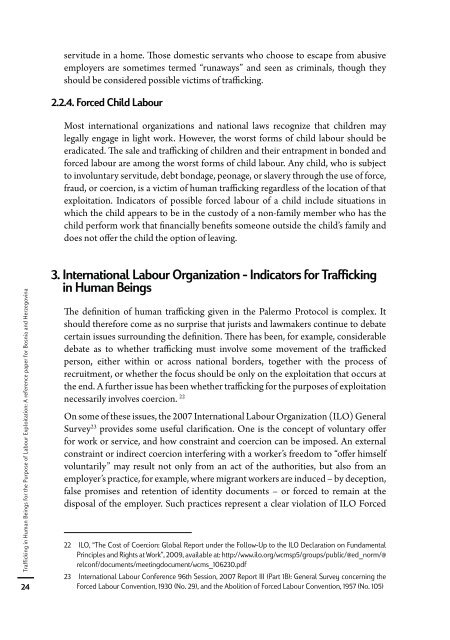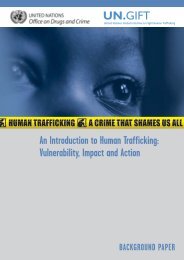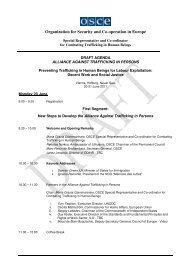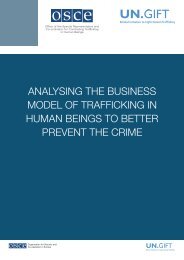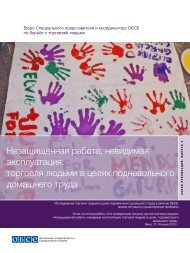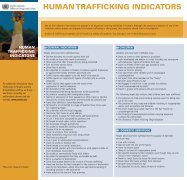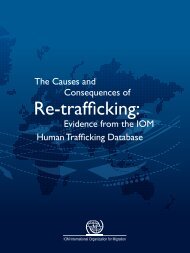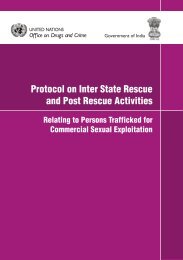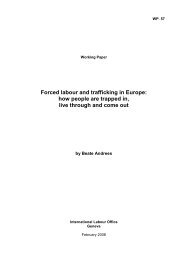Trafficking in human beings for the purpose of labour exploitation - A ...
Trafficking in human beings for the purpose of labour exploitation - A ...
Trafficking in human beings for the purpose of labour exploitation - A ...
You also want an ePaper? Increase the reach of your titles
YUMPU automatically turns print PDFs into web optimized ePapers that Google loves.
servitude <strong>in</strong> a home. Those domestic servants who choose to escape from abusive<br />
employers are sometimes termed “runaways” and seen as crim<strong>in</strong>als, though <strong>the</strong>y<br />
should be considered possible victims <strong>of</strong> traffick<strong>in</strong>g.<br />
2.2.4. Forced Child Labour<br />
Most <strong>in</strong>ternational organizations and national laws recognize that children may<br />
legally engage <strong>in</strong> light work. However, <strong>the</strong> worst <strong>for</strong>ms <strong>of</strong> child <strong>labour</strong> should be<br />
eradicated. The sale and traffick<strong>in</strong>g <strong>of</strong> children and <strong>the</strong>ir entrapment <strong>in</strong> bonded and<br />
<strong>for</strong>ced <strong>labour</strong> are among <strong>the</strong> worst <strong>for</strong>ms <strong>of</strong> child <strong>labour</strong>. Any child, who is subject<br />
to <strong>in</strong>voluntary servitude, debt bondage, peonage, or slavery through <strong>the</strong> use <strong>of</strong> <strong>for</strong>ce,<br />
fraud, or coercion, is a victim <strong>of</strong> <strong>human</strong> traffick<strong>in</strong>g regardless <strong>of</strong> <strong>the</strong> location <strong>of</strong> that<br />
<strong>exploitation</strong>. Indicators <strong>of</strong> possible <strong>for</strong>ced <strong>labour</strong> <strong>of</strong> a child <strong>in</strong>clude situations <strong>in</strong><br />
which <strong>the</strong> child appears to be <strong>in</strong> <strong>the</strong> custody <strong>of</strong> a non-family member who has <strong>the</strong><br />
child per<strong>for</strong>m work that f<strong>in</strong>ancially benefits someone outside <strong>the</strong> child’s family and<br />
does not <strong>of</strong>fer <strong>the</strong> child <strong>the</strong> option <strong>of</strong> leav<strong>in</strong>g.<br />
<strong>Traffick<strong>in</strong>g</strong> <strong>in</strong> Human Be<strong>in</strong>gs <strong>for</strong> <strong>the</strong> Purpose <strong>of</strong> Labour Exploitation: A reference paper <strong>for</strong> Bosnia and Herzegov<strong>in</strong>a<br />
24<br />
3. International Labour Organization - Indicators <strong>for</strong> <strong>Traffick<strong>in</strong>g</strong><br />
<strong>in</strong> Human Be<strong>in</strong>gs<br />
The def<strong>in</strong>ition <strong>of</strong> <strong>human</strong> traffick<strong>in</strong>g given <strong>in</strong> <strong>the</strong> Palermo Protocol is complex. It<br />
should <strong>the</strong>re<strong>for</strong>e come as no surprise that jurists and lawmakers cont<strong>in</strong>ue to debate<br />
certa<strong>in</strong> issues surround<strong>in</strong>g <strong>the</strong> def<strong>in</strong>ition. There has been, <strong>for</strong> example, considerable<br />
debate as to whe<strong>the</strong>r traffick<strong>in</strong>g must <strong>in</strong>volve some movement <strong>of</strong> <strong>the</strong> trafficked<br />
person, ei<strong>the</strong>r with<strong>in</strong> or across national borders, toge<strong>the</strong>r with <strong>the</strong> process <strong>of</strong><br />
recruitment, or whe<strong>the</strong>r <strong>the</strong> focus should be only on <strong>the</strong> <strong>exploitation</strong> that occurs at<br />
<strong>the</strong> end. A fur<strong>the</strong>r issue has been whe<strong>the</strong>r traffick<strong>in</strong>g <strong>for</strong> <strong>the</strong> <strong>purpose</strong>s <strong>of</strong> <strong>exploitation</strong><br />
necessarily <strong>in</strong>volves coercion. 22<br />
On some <strong>of</strong> <strong>the</strong>se issues, <strong>the</strong> 2007 International Labour Organization (ILO) General<br />
Survey 23 provides some useful clarification. One is <strong>the</strong> concept <strong>of</strong> voluntary <strong>of</strong>fer<br />
<strong>for</strong> work or service, and how constra<strong>in</strong>t and coercion can be imposed. An external<br />
constra<strong>in</strong>t or <strong>in</strong>direct coercion <strong>in</strong>terfer<strong>in</strong>g with a worker’s freedom to “<strong>of</strong>fer himself<br />
voluntarily” may result not only from an act <strong>of</strong> <strong>the</strong> authorities, but also from an<br />
employer’s practice, <strong>for</strong> example, where migrant workers are <strong>in</strong>duced – by deception,<br />
false promises and retention <strong>of</strong> identity documents – or <strong>for</strong>ced to rema<strong>in</strong> at <strong>the</strong><br />
disposal <strong>of</strong> <strong>the</strong> employer. Such practices represent a clear violation <strong>of</strong> ILO Forced<br />
22 ILO, “The Cost <strong>of</strong> Coercion: Global Report under <strong>the</strong> Follow-Up to <strong>the</strong> ILO Declaration on Fundamental<br />
Pr<strong>in</strong>ciples and Rights at Work”, 2009, available at: http://www.ilo.org/wcmsp5/groups/public/@ed_norm/@<br />
relconf/documents/meet<strong>in</strong>gdocument/wcms_106230.pdf<br />
23 International Labour Conference 96th Session, 2007 Report III (Part 1B): General Survey concern<strong>in</strong>g <strong>the</strong><br />
Forced Labour Convention, 1930 (No. 29), and <strong>the</strong> Abolition <strong>of</strong> Forced Labour Convention, 1957 (No. 105)


